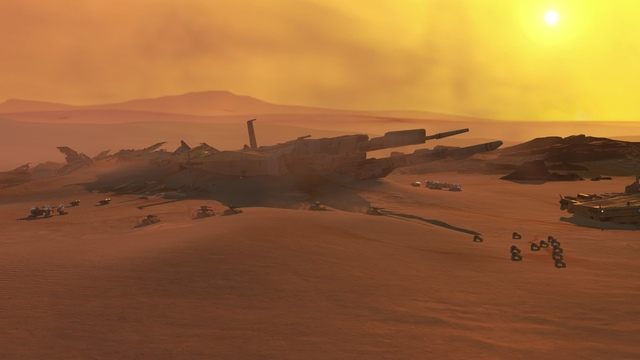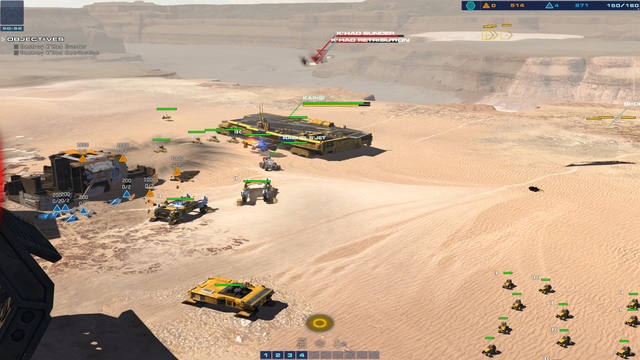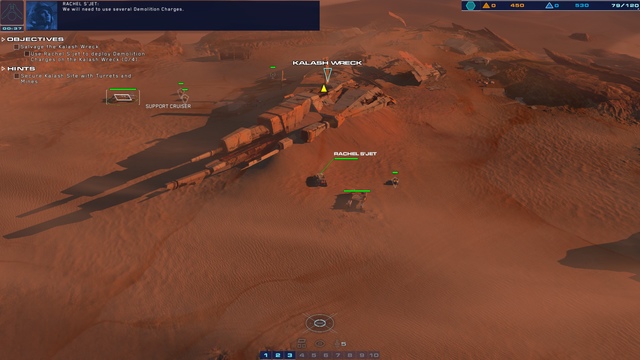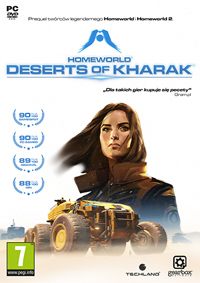Homeworld: Deserts of Kharak review – a galaxy’s worth of sand
Real-time strategy games, as a genre, are dying. That’s why every new RTS premiere I see is a reason to celebrate. All the more so if the game belongs to one of my favorite series.
The review is based on the PC version.

- atmosphere;
- audiovisuals;
- intriguing plot;
- very dynamic gameplay;
- classic mechanics employing new solutions.
- limited multiplayer options;
- unit diversity could have been better;
- hardly challenging, except for the highest difficulty level.
Homeworld: Deserts of Kharak, previously known as Hardware: Shipbrakers, was developed by Blackbird, a developer team employing several of the staff that was responsible for the success of the iconic space RTS. Be that as it may, as the studio had no IP rights to the brand, the game was intended to be simply a spiritual successor to the franchise. Some concerns were raised from the fact that Shipbrakers was supposed to be a free to play, multiplayer only, online strategy game. The situation changed, however, when Gearbox, the current owner of the Homeworld franchise, contacted the developers and put an end to Hardware - instead of being a free to play MMO, it became a full-fledged entry in the franchise. And thank the stars!
Adventures on a desert
Homeworld, as a series, always emphasized the plot - each and every story depicted in the games focused on a journey in which the wandering was also the driving force; Deserts of Kharak is no exception. The main heroine, Rachel S’jet, is the chief science officer of an expedition dispatched to examine a strange anomaly located deep beneath the sands of the ever-growing desert. Kharak, the planet that serves as the background for the story, is dying, and the strange anomaly can be the only thing that can save it. The flagship and the core of the expedition is the land carrier Kapisi – replacing the motherships from previous installments. The deserts, however, are rather high on the not-the-most-pleasant-places-to-spend-your-vacation list, making it a rather dangerous environment for the members of the expedition. Some of the dangers come from the environment itself, others from the hostile locals, who are not very fond of your little excursions.

The story depicted in the latest game from Blackbird Interactive provides a great background for the gameplay; it is interesting, engaging, and very intriguing, providing numerous mysteries along the way that you just can’t wait to see solved. The characters may not be the best we met in fiction, as they lack any significant depth, but this doesn’t prevent us from enjoying the game. They are doing their part in pushing the story forward and that’s enough.
Deserts of Kharak features one more, essential, character – the desert. The game abandons the long-standing tradition and moves the action from the vast depths of space onto the surface of a single planet. As the space did in the previous Homeworlds, the eponymous deserts plays a key role in the story by building its atmosphere. The sands seem endless, like a void, amidst which the characters were thrown, and the desert is both beautiful and merciless. If, as long-time fans, you were worried that a different setting will kill the series’ distinctive feel, you can rest easy. The sands, dunes, and rocks can be equally uninhabitable and intimidating.
However, there are other things that qualify Deserts of Kharak as a full-fledged entry in the franchise. Well-executed animated cut-scenes present in-between missions are back, and the narrative during the missions themselves is the same good old storytelling we experienced in the past. Still, it’s the mechanics, maybe even more than the narrative, that makes Deserts of Kharak a Homeworld game.

One of the main inspirations for the Homeworld series was the novel, Dune, by Frank Herbert. You can tell after having seen the game’s nomenclature, overall naming sense, and ever-present exotic motifs. Rob Cunningham, the game’s lead artist, took inspiration from the works of Chris Foss, created for Alejandro Jodorowsky’s intended, but ultimately unsuccessful, movie adaptation of the novel. While Jodorowsky’s adaptation never came to be, Foss’ concept art remained, contributing significantly to the visual designs of the Homeworld series.
It’s a whole new (Home)world
Gameplay-wise, the game is a collection of classic solutions, typical of virtually every modern RTS. We gather resources, build units, fight hostile forces, and complete various missions objectives. However, under the disguise of classic there are things that significantly beef up the gameplay and provide it with modern touch. We don’t build a base, per se, anymore, as we used to in previous entries. Instead, we get the Kapisi, which serves as our science and production center. It also offers much more mobility and firepower than a typical space mothership. Furthermore, her functions are divided into four subsystems, powered by energy points at our disposal, which is a completely new feature. Our energy reserves increase with every subsequent mission, but we could always use some more, and we have to carefully consider where to place them. Otherwise, Kapisi’s systems may overheat, which – as you probably already guessed – won’t end well.

You will soon find out that she’ll need that mobility too. The gameplay in Deserts of Kharak emphasizes constant movement. The resources, scattered scarcely throughout the map, are rarely abundant, forcing you to move your mining equipment on a regular basis. Some special support units provide you with the capability to gather resources from several points simultaneously. Which still means that most of the time your forces will be scattered. Serving as a precious in-game currency, other than the resources, are the alien artifacts we can sometimes find in wreckages of unknown origin. Each of them can grant our carrier with a unique trait, i.e. increasing the effectiveness of a specific unit type or adding a new production line, allowing us to build up our forces faster. Remember to always check the wreckages. Who knows what treasures you’ll find?
Your tanks are on my desert
Easy to say though, because getting to the wreckages, as well as gathering the resources, requires you to constantly push the frontline. To do this you need an army - which has to be built on the Kapisi. The units are divided into several classes – light armored but fast vehicles, armored tanks, slow, but packing the hardest punch, cruisers, and air forces. Deserts of Kharak is based on the usual tactical rock-paper-scissors. Light units, thanks to their speed, make short work of artillery, tanks demolish light armor, and the artillery wipes the floor with tanks. Air units are mostly glass cannons – they have good firepower but are very easy to take down.

Virtually every unit has at least one passive or active ability. Use them effectively and you’re much closer to victory. Tanks, for example, are equipped with smoke grenades that reduce the enemy’s field of view. Furthermore, our forces gain experience and level up as the campaign progresses, which means they become more and more powerful with each mission they manage to survive. The diversity of available units is not very impressive. While they are not terribly few, there’s not enough of them to allow us to employ different, more creative tactics. The same goes to their appearances. The 3D models are usually constructed from several simple shapes and lack more detailed, distinctive features.
What Deserts of Kharak does excel at is bringing classic gameplay mechanics up to modern standards. The battles may be smaller in scale than in previous Homeworlds, but they prove to be more dynamic. You can tell that Blackbird was looking up to Starcraft 2 when they were speeding up the pace of the gameplay. Units are built fast, but it doesn’t take much – usually a moment of carelessness – for them to die equally fast. Fast pace and the constant necessity to relocate your forces keep the player entertained. Moving the action down to the surface resulted in some additional tactical options. Employing the terrain advantage can really pay off, and the map layouts seem to encourage this more than anything. Sometimes we get hit with a weather anomaly (like tornadoes), which can damage our units. It’s a shame it doesn’t happen more often though. I was under the impression that the creators came up with this little gem in a spark of genius and then completely forgot about its existence.

The single player is where one of my two serious issues with Homeworld: Deserts of Kharak comes out – the difficulty level. For those of you who cut their teeth playing real-time strategies, the normal difficulty (second out of three) will be a piece of cake. Not that it will be boring, the missions will be just way too simple; thanks to the enemy AI, among other things. For example: my objective was to destroy an enemy cruiser patrolling a section of the map. I placed a number of turrets along its patrol route, in plain sight. And what did he do? He rode right through the middle of this obvious kill zone and got himself wrecked. There was no need to move any other units, all it took was a bunch of turrets. In skirmishes the AI fares no better. If you’ve got experience with RTS games, and yet would like some challenge from Deserts of Kharak, my advice is to pick the highest difficulty right from the start.
All the colors of the sand
The newest Homeworld looks more than nice, and the explosions and particle effects are an outright eye-candy, but the strongest point of the game’s visuals is, without a doubt, our carefully-designed sandbox itself. The creators play with lighting, dune and rock layouts, or the day and night cycle, making even the desert, which is basically a vast and desolate sea of sand and gravel, a beautiful place.
The audio doesn’t fall behind the graphics in terms of quality. The music was composed by Paul Ruskay, author of all the previous Homeworld soundtracks. Its exotic sound creates a pleasant contrast with story, giving it a more primal vibe. Deserts of Kharak can boast a great voice-over on average, but even then the dialogues between the units take the cake. To be specific, I’m not talking about their responses when taking orders; I’m talking about the moments when nothing happens. Then, you can hear the crews chatting, reporting, and so on. That’s one more aspect that significantly adds to the game’s distinctive atmosphere.

This dune is too small for the two of us
If there’s one thing that determines the “lifespan” of an RTS, it’s not the single- but the multiplayer mode. Deserts of Kharak has one of those, but I doubt anyone with hours of experience in Starcraft 2 would find it even half as engaging. We have two factions to pick from: the Coalition and the Gaalsien, both of them similar when it comes to gameplay. They do have some differences but none of those differences are very significant.
There are two alternative victory conditions: destroying the enemy carrier or capturing five artifacts. The gameplay is simple, not very engaging, and intended for those of you who go online from time to time, in between subsequent campaign missions. The number of available maps is also rather modest. While the creators assure that they have big plans for further development of the multiplayer, for now it is quite underwhelming. And I hope their plans are good ones, because it’s the game’s popularity that will decide the fate of the potential sequel.
A successful comeback?
Despite the abovementioned concerns, Homeworld: Deserts of Kharak turns out to be a very good RTS and a worthy representative of both the Homeworld franchise as well as the whole genre. To be honest, I wasn’t expecting much from this game. It’s been 10 years since the last entry in the series, and the game’s prolonged development cycle didn’t inspire much optimism in me. And yet, Blackbird delivered a very good game that provides tons of entertainment. Homeworld is beautiful once again, it’s story intriguing, and its gameplay well-designed. I sincerely hope that it will be a prelude to subsequent new games. Perhaps sooner than later we can expect an announcement of Homeworld 3? I’ll admit that I would be very pleased should that turn out to be the truth, because after Deserts of Kharak I’m eager for more.
Homeworld: Deserts of Kharak
Homeworld: Deserts of Kharak review – a galaxy’s worth of sand
Real-time strategy games, as a genre, are dying. That’s why every new RTS premiere I see is a reason to celebrate. All the more so if the game belongs to one of my favorite series.

